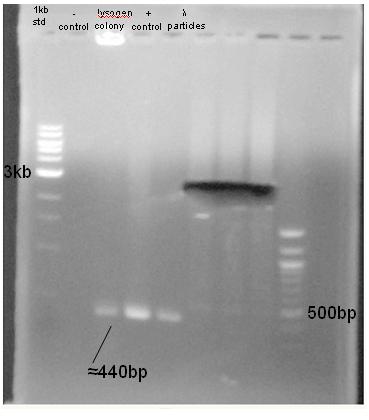Team:Rice University/Notebook/20 June 2008
From 2008.igem.org
Friday, 20 June
- Taylor Stevenson:
- Lysis Assay of VCS257 SupA+
- Cells were grown O/N @ 37*C in Lambda media.
- 4.5mL culture was infected with 4.5uL of phage packaging product from November, 2007 and allowed to incubate for 20min @ 37*C shaking @ 250 rpm.
- Infected culture was heat shocked @ 42*C for 20min, inducing lysis by denaturing the CI857 repressor.
- Cells were then grown and their optical density was measured at different time points after heat shock.
- Result-lysis was never observed. Cells may need to be maintained at higher temperature to ensure all phage infections result in lysis.
- Result-An infected VCS257 culture was streaked onto LB-agar. Isolated colonies were used to innoculate a 96 deep-well plate which was grown O/N @ 30*C shaking @ 300rpm. Using the well replicator, each of the wells was spotted onto two large petri dishes. One dish was grown @ 30*C and the other was grown @ 42*C O/N. Spots that grew on 30*C plates and not on 42*C plates are lysogens as the phage infected cells would lyse due to the temperature sensitive cI. The plates show that there is only one colony that could be a possible lysogen.
- The possible lysogen colony was streaked onto LB plates to be grown O/N @ 30*C and 42*C to verify temperature screen.
- A colony PCR was performed on the possible lysogen using the CroF and CroR primers. If a copy of the lambda genome is incorporated into the lysogen's, the PCR should result in amplification of the phage gene cro and produce a 400bp product. Additionally, three other PCR reactions were performed in parallel.
- -negative control using water
- -positive control using lambda DNA
- -second sample using lambda particles from stocks
- Result-PCR gel analysis shows that the bacterial colony, phage DNA, and lambda particles all produce a PCR product at approximately 440bp, where the amplified cro should be. This data further supports the conclusion that the screened colony is a lysogen, and that it is possible to use packaged phage DNA as a template in a PCR.
- Result-Temperature screen of the colony showed that streaked plates did not grow colonies @ 42*C and grew an abundant number @ 30*C.

 "
"
